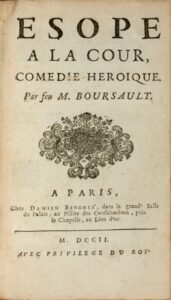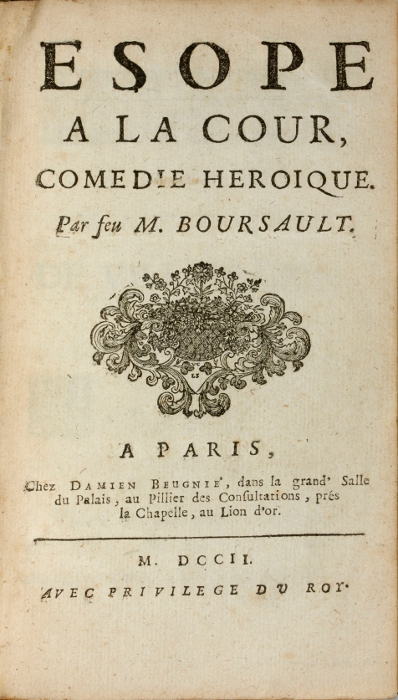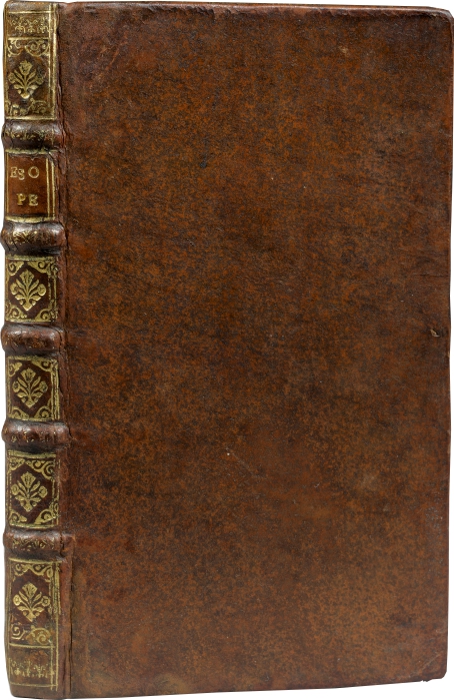Paris, Damien Beugnié, 1702.
12mo [160 x 90 mm] of (10) ll. the first one blank, 97 pp., (1) bl. p., (1) bl. l. Bound in contemporary full mottled roan, spine ribbed decorated with gilt fleurons, sprinkled edges. Contemporary binding.
Rare posthumous first edition of this comedy by Boursault which was represented for the first time after his death, in 1701.
Bulletin Morgand et Fatout 6512; Catalogue Gui Pellion 482.
“Boursault (1638-1701) is one of those playwrights who, in the 17th century, were in vogue for lack of glory, and whose productions are still estimated today. When he came to Paris in 1651, he only knew the patois from his province: a few years later, he had become a writer remarkable enough so he was made responsible for composing a book intended to the education of the Dauphin. Boursault was popular for the qualities of his heart as well as for the ones of his mind; his frank and open character got him many friends. He was connected with most people of letters, his contemporaries, if we except Moliere.”
Ésope à la cour is a comedy in 5 acts and in verses with a vivid spirit, with a frank comedy and a natural style. As he was a protégé of the king, the author of Esope à la cour was obliged to withdraw a few passages of his play that contained abusive allusions towards Louis XIV.
“Esope à la cour, in five acts, was performed after Boursault’s death, in 1701. Boursault wrote it right after ‘Esope à la ville’, but censorship forbad the play because of its subject. When finally the performing authorization was granted, the author was dead. In this comedy, Esope managed to be accepted at the Court, and naturally, he finds a way to practice his irony and his wisdom towards the countless ridiculous particularities and the vices of the courtiers. Montesquieu declared that after he attended the performance of Esope à la Cour, he felt the need to become a man of goodness.” (Dictionnaire des Œuvres, II, 684).
There are actually two different issues in 1702, one with the address of Damien Beugnié, the other one with Veuve de Clément Gasse.
The work is dedicated to Madame de Villequier, Françoise Angélique de la Mothe-Houdancourt, born in 1650 and married to Louis-Marie-Victor, Duc d’Aumont and Marquis de Villequier.
Louis-Marie-Victor d’Aumont, one of the most enthusiastic servants of Louis XIV, distinguished himself in the Flanders campaign. Madame de Villequier’s sister, Charlotte-Eléonore de la Mothe-Houdancourt was the governess of Louis XV.
The relationship between the author and the marquess of Villequier are obvious since Louis XIV offered Boursault to become the sub tutor of his son while Madame de Villequier’s sister was the governess of Louis XV. Finally, Boursault saved one of his plays from being censored in 1690 thanks to the support of the duke of Aumont.
Esope à la cour permitted his author to put back in vogue the fable and to raise a few objections to Louis XIV.
A beautiful wide-margined copy of this rare comedy, preserved in its contemporary full binding.
Our researches allowed us to locate copies of this issue in 3 French public Institutions: B.n.F., Bibliothèque de Rennes and Paris Sorbonne.
However the copy preserved at the B.n.F. presents a different collation from ours and it doesn’t comprise the very interesting Privilège du Roy which occupies 3 pages of our copy and in which we learn that it is Michelle Milley, Sir Boursault’s widow, who wanted this play to be printed after the death of her husband. This Privilege, dated January 22nd 1702, also tells us that Boursault’s widow transferred her right to Clement Gasse and to Damien Beugnié, booksellers in Paris, on February 1st, 1702.



